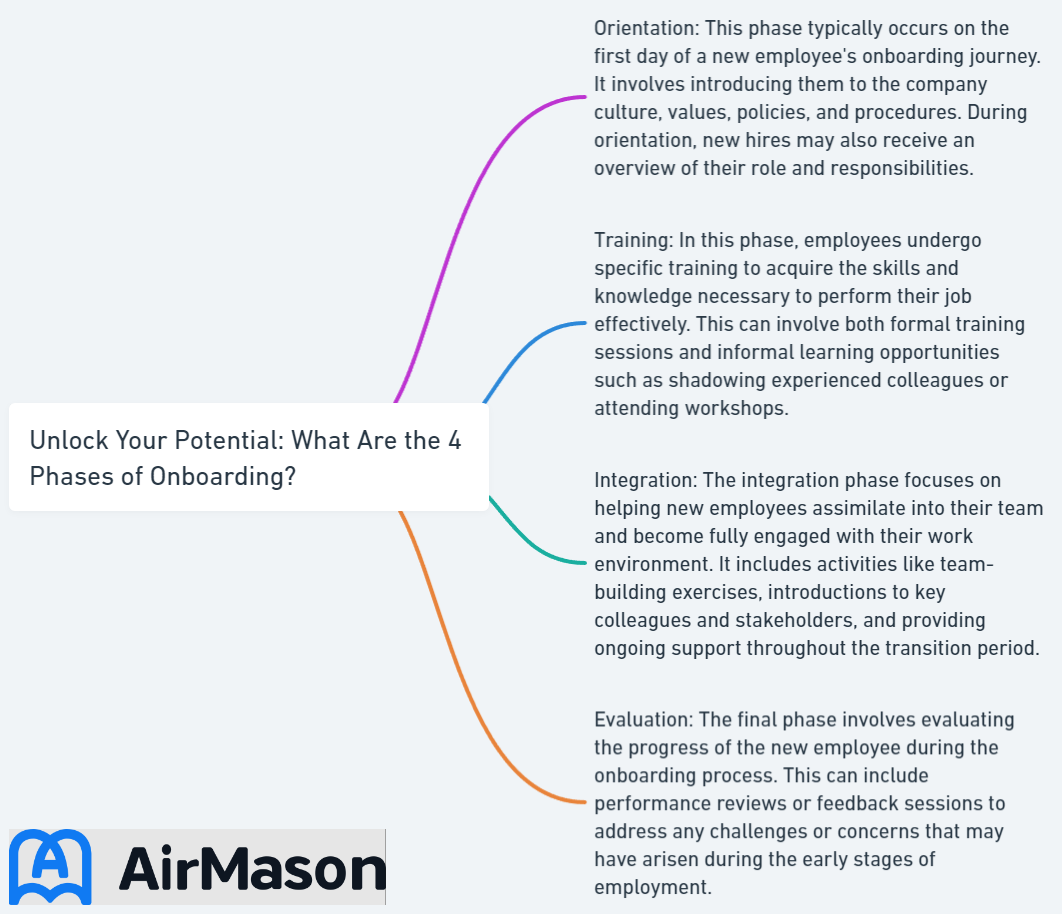
Have you ever wondered why some organizations have a high retention rate and employee satisfaction? The secret lies in their employee onboarding process. In this blog post, we will delve deep into the world of onboarding, exploring its importance, benefits, challenges, and “what are the 4 phases of onboarding” that ensure a smooth and successful experience for new hires. Get ready to unlock your organization’s potential by mastering the art of onboarding!
Key Takeaways
- Employee onboarding is essential for job satisfaction, retention and development.
- Successful onboarding involves pre-onboarding, orientation & welcoming, role specific training and integration & ongoing development.
- Best practices such as customization, utilization of technology and tracking progress should be implemented to ensure a successful process.
The Importance of Employee Onboarding
Employee onboarding is the process that helps new hires feel comfortable, confident, and familiar with the company culture, goals, and expectations, ultimately leading to increased job satisfaction and retention. A structured onboarding program not only sets the foundation for a positive employee experience, but also ensures a high retention rate, as poorly conducted onboarding can leave new hires feeling demotivated and more likely to leave the organization.
An effective onboarding process goes beyond just the initial introduction to the company; it paves the way for successful employee onboarding, fostering a sense of belonging and commitment to the organization’s long-term success. This also contributes to ongoing employee development.
Navigating the complexities of employee onboarding, we first turn our attention to its benefits and challenges.

Benefits of Effective Onboarding
An effective onboarding process brings numerous benefits, such as increased employee engagement, productivity, and retention. Onboarding aids in forging a strong connection between the employee and the organization by familiarizing new employees with the company culture and objectives, which in turn leads to heightened job satisfaction and allegiance to the company’s mission and vision. In fact, research shows that a well-executed onboarding process can result in an 82% increase in new hire retention.
The quality and dedication put into the onboarding process are more important than its duration. A comprehensive and well-structured onboarding program that includes relationship building and clear job expectations can help new employees transition seamlessly into their roles and adapt to the corporate culture, setting them up for long-term success.
Common Onboarding Challenges
Despite the numerous benefits of effective onboarding, organizations often face common challenges that hinder the onboarding process. These challenges include a lack of personalization, inadequate training, and insufficient support from management. Overcoming these obstacles is essential for ensuring a successful onboarding experience and fostering employee retention.
When management fails to provide adequate support during the onboarding process, it can lead to:
- Increased employee dissatisfaction and turnover
- Decreased confidence in new roles
- Reduced engagement
- Higher risk of underperformance
As we move forward, we will explore the four key phases of onboarding that, when executed correctly, can help organizations overcome these challenges and create a positive onboarding experience for new hires.
Employee Onboarding
Employee onboarding is a crucial process in any organization, encompassing the steps taken to integrate a new hire into the company’s culture, workflow, and expectations. Effective employee onboarding sets the stage for a successful professional journey by providing the necessary tools, information, and support right from day one. This comprehensive approach ensures that the newcomer not only understands their role but also feels connected to the broader mission and vision of the company. Through structured onboarding programs, companies can streamline the transition period, accelerating the time it takes for employees to become productive contributors. Moreover, a well-designed onboarding process fosters a positive first impression, boosting employee morale and engagement. By emphasizing employee onboarding, organizations lay the foundation for long-term retention, as well as the development of a motivated and committed workforce.
The Four Key Phases of Employee Onboarding

The four essential phases of onboarding, starting with initial onboarding, are:
- Pre-onboarding
- Orientation and welcoming
- Role-specific training
- Integration and ongoing development
These phases are critical in ensuring a smooth transition for new employees and contribute to their long-term success within the organization. The objectives of successful onboarding, as per Dr. Talya Bauer, include compliance, clarification, culture, and connection.
Grasping and executing these four phases is vital for creating an effective onboarding process that fully assimilates new hires into the organization. We’ll now delve into each phase and its importance in the onboarding process.
Phase 1: Pre-Onboarding
The pre-onboarding phase is an important step of the employee onboarding process. It serves as the foundation of the whole process. It involves preparing all the necessary elements before the new hire’s first day, such as completing administrative tasks, contract signing, and document review. This phase aims to lessen apprehension and encourage commitment, thereby decreasing employee attrition.
Examples of pre-onboarding activities include offering a warm welcome, introducing new employees to key team members, and ensuring that all necessary onboarding documents are completed. Effectively managing the pre-onboarding phase allows organizations to lay the groundwork for a seamless and successful onboarding experience.
Phase 2: Orientation and Welcoming
The orientation phase is the next crucial step in the onboarding process. Its purpose is to introduce new employees to the team, company policies, and expectations, as well as assigning an onboarding buddy. This phase should not exceed one week.
During the orientation process, topics such as the organization’s culture, attendance, time off, payroll, medical insurance policies, and facilities in the office building should be addressed. Assigning an onboarding buddy helps foster connections and assists new hires in orienting themselves to the workplace, reducing the likelihood of feeling disconnected.
Phase 3: Role-Specific Training
Role-specific training is the third phase of employee onboarding, which ensures new hires comprehend their duties, tools, and expectations, and obtain necessary assistance from their team and management. This phase involves:
- Informing new employees about their day-to-day responsibilities
- Equipping them with the necessary tools and resources
- Providing training on specific tasks and processes
- Offering guidance and support from their team and management
This training is crucial for setting new employees up for long-term success in their new job.
Role-specific training can be facilitated through various learning methods, such as blended, micro-learning, and self-paced. Interactive technology, like virtual reality, can be employed to maintain learner engagement and provide simulated experiences in workplace safety. This phase is crucial for the efficacy of newly employed personnel and their contentment in the organization, as it provides insight into the organization’s regulations, products, mission, and vision.
Phase 4: Integration and Ongoing Development
The final phase of employee onboarding, integration and ongoing development, involves providing regular feedback, self-paced learning opportunities, and HR check-ins to assist employees in their professional and personal growth. This phase includes periodic one-on-one meetings with Human Resources to review performance and progress, as well as consistent feedback. The employer may also provide self-paced learning and other opportunities for the employee to further their professional growth.
The aim of continued development is to devise a comprehensive career progression and individual development plan for the employee to remain with the organization for the long term and ascend the corporate hierarchy. By successfully implementing this phase, organizations can ensure that new employees are fully integrated and committed to the company’s success.
Best Practices for a Successful Onboarding Process

To ensure a smooth and effective onboarding experience for new hires, organizations should follow some best practices, such as customization and personalization, utilizing technology, and tracking progress and gathering feedback. These practices help create an engaging, relevant, and successful onboarding process that benefits both the new employee and the organization.
Implementing these best practices enables organizations to tackle common onboarding challenges and foster a positive onboarding experience for new hires. We will now explore each of these practices and their importance in the onboarding process further.
Customization and Personalization
Customization and personalization involve adapting the onboarding process to each employee’s specific requirements, role, and background, thus providing a more engaging and relevant experience. Creating a customized onboarding experience assures that new hires feel valued and understood, thereby fostering increased job satisfaction and allegiance to the company.
Examples of companies that have successfully customized and personalized their onboarding process include:
- Airbnb
- Netflix
- Salesforce
These organizations showcase the benefits of implementing a well-structured, personalized, and technology-driven onboarding process.
Utilizing Technology
Utilizing technology, such as onboarding software and virtual reality, can streamline the process, improve engagement, and provide valuable resources for new hires. Onboarding software programs can facilitate the process and offer beneficial resources, such as eloomi’s onboarding software, which can be incorporated into an employee onboarding checklist to facilitate the process and supply new hires with all the requisite information.
Facebook, for example, integrates technology into their onboarding process by utilizing HRMS to automate tasks and expedite employee onboarding by employing DocuSign CLM, which saves their global HR team more than 40 hours per week. Leveraging technology in onboarding can greatly enhance the overall experience for new employees.
Tracking Progress and Gathering Feedback
Tracking progress and gathering feedback in the onboarding process is of great importance to guarantee that new hires are maximizing the onboarding experience. Monitoring progress can facilitate the recognition of areas in need of improvement and guarantee that new hires are achieving their objectives. Collecting feedback from new hires can facilitate the identification of any issues or areas that require attention.
Strategies that can be implemented to effectively gather feedback from new hires during onboarding include asking open-ended questions, conducting surveys, establishing a feedback culture, and providing regular follow-up. Tools and technologies employed to track progress and collect feedback during the onboarding process include Quantum Workplace, Zavvy, Process Street, and CultureMonkey.
Onboarding Guide
The onboarding guide is an essential resource for new employees as they embark on their journey within an organization. This comprehensive document provides a structured roadmap, outlining the various steps and processes involved in getting acclimated to the company culture and workflow. From filling out important paperwork to familiarizing oneself with company policies and procedures, the onboarding guide serves as a valuable reference tool. It typically includes an introduction to key team members, an overview of the company’s mission and values, and a breakdown of job-specific responsibilities. Moreover, the guide often includes information about training programs, resources, and tools that will aid in the employee’s professional development. By following the onboarding guide meticulously, new hires can transition smoothly into their roles, ensuring a positive and productive start to their tenure with the company.
Real-World Examples of Successful Onboarding Programs

Google, Microsoft, Zappos, and Facebook exemplify successful onboarding programs, illustrating the benefits of a well-structured, individualized, and technology-driven onboarding procedure. By examining these real-world examples, organizations can gain valuable insights into the best practices and strategies that lead to a successful onboarding process.
Google’s onboarding program, for example, focuses on encouraging employees to inquire and voice their feedback, supporting personnel development through education, and concentrating on practical and cognitive learning to foster connections between employees. Microsoft, on the other hand, implements role-specific training during onboarding by supplying employees with the necessary tools, knowledge, and best practices pertinent to their roles, streamlining the onboarding process, and providing tailored training for new employees.
Zappos, known for its unique onboarding program, focuses on fostering a sense of belongingness, delivering WOW customer service, hiring based on core values, and creating a culture of happiness and fun in the workplace. Facebook, a technology-driven company, integrates technology into their onboarding process by utilizing HRMS to automate tasks and expedite employee onboarding by employing DocuSign CLM, which saves their global HR team more than 40 hours per week.
These real-world examples showcase the benefits of implementing a well-structured, personalized, and technology-driven onboarding process, setting the stage for long-term employee satisfaction and retention.
Trends in Onboarding
The landscape of onboarding is constantly evolving to meet the changing needs of organizations and employees. Recent trends in onboarding reflect a shift towards more personalized and tech-driven experiences. One prominent trend is the integration of virtual reality (VR) and augmented reality (AR) technologies to create immersive onboarding experiences. This allows new hires to familiarize themselves with the workplace environment, even before their first day. Additionally, companies are placing a greater emphasis on social integration during onboarding, fostering connections among new hires through team-building activities and mentorship programs. Another notable trend is the adoption of automation and artificial intelligence (AI) in the onboarding process, streamlining administrative tasks and enabling HR teams to focus on more strategic aspects of integration. Furthermore, remote onboarding has become increasingly prevalent, leveraging digital tools and platforms to seamlessly welcome and train employees who may not be physically present in the office. These trends in onboarding collectively aim to enhance the overall experience for new hires, setting the stage for their success within the organization.
Summary
In conclusion, employee onboarding is a critical process that ensures new hires feel comfortable, confident, and familiar with the company culture, goals, and expectations. By understanding and implementing the four key phases of onboarding, organizations can create a smooth and effective onboarding experience for new hires. The best practices discussed in this blog post, such as customization and personalization, utilizing technology, and tracking progress and gathering feedback, will help organizations enhance their onboarding process and ultimately lead to increased job satisfaction and retention. With these insights, you are now equipped to unlock your organization’s potential by mastering the art of onboarding.
Frequently Asked Questions
What is the 4 step onboarding process?
The four steps of onboarding are pre-boarding, orientation, training, and integration. eloomi provides customizable tools to ensure each phase of the process is successful for new employees.
What are the 4 C’s of employee onboarding?
The 4 C’s of employee onboarding are Compliance, Clarification, Connection and Culture. These components are integral for successful integration of new employees into an organization and were first developed a decade ago based on research done by the SHRM Foundation.
What are the 5 C’s of onboarding?
The 5 C’s of onboarding are compliance, clarification, confidence, connection and culture; key aspects to ensure an effective onboarding process.
What is the significance of customization and personalization in the onboarding process?
Customization and personalization of the onboarding process provide employees with an engaging and tailored experience that aligns with their individual roles and backgrounds.
How can technology enhance the onboarding process?
Technology can help streamline the onboarding process, improve engagement, and provide new hires with valuable resources, making it a more efficient and enjoyable experience.